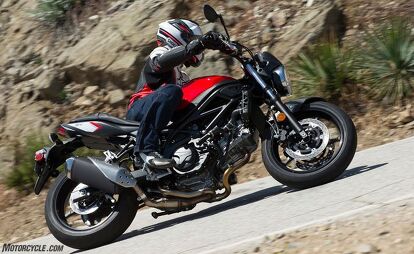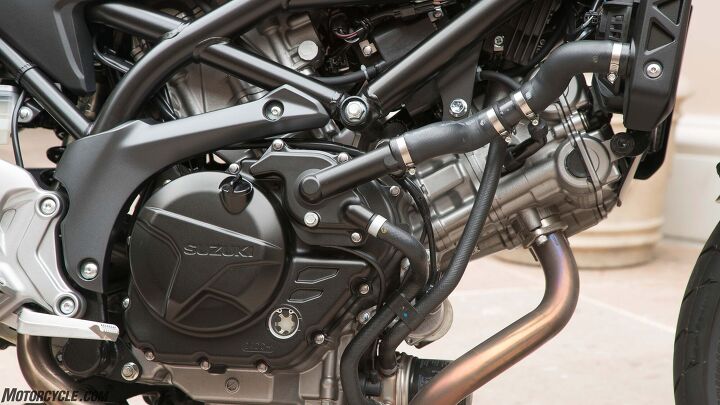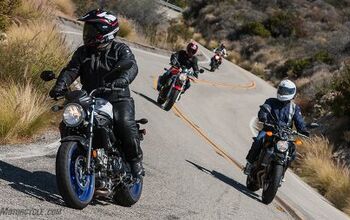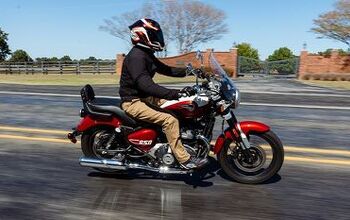2017 Suzuki SV650 First Ride Review

The magic is back!
Here at MO, we’ve made it perfectly clear Suzuki missed the boat with the Gladius, the awkwardly styled and poorly-named successor to the hugely popular SV650. A name change to SFV650 wasn’t enough to fool us, either. By virtue of its stellar engine, the SFV held its own in the various comparison tests we placed it in, but it fell a little short of being a true SV successor. Then factor in the exorbitant price tag the Gladius/SFV carried – up to $8,149 in 2014 – and Suzuki had a tall order trying to win back fans of the SV650.
2017 Suzuki SV650
| Engine | 18.5/20 |
| Suspension/Handling | 11.0/15 |
| Transmission/Clutch | 8.0/10 |
| Brakes | 7.0/10 |
| Instruments/Controls | 4.0/5 |
| Ergonomics/Comfort | 8.0/10 |
| Appearance/Quality | 8.0/10 |
| Desirability | 9.0/10 |
| Value | 9.5/10 |
| Overall Score | 83/100 |
2014 Middleweight Mash-Up Six-Way Shootout!
Turns out Suzuki heard our mockery and had enough. With the 2017 Suzuki SV650, coming to a dealership near you in June, Suzuki decided to return to the SV’s roots with this latest model, delivering a simple, honest and affordable motorcycle that’s both rewarding and fun to ride. The best part? It’ll only set you back $6,999 (or $7,499 with ABS), a mere $9 more than Yamaha’s appealing FZ-07.
It’s All In The Engine
The best part about the SV has always been its engine, and the 645cc V-Twin remains the star here. Suzuki says more than 140 components on the SV are new or heavily revised compared to the SFV, and more than 60 of those changes are said to be in the dual-spark engine alone. The result, say the folks in Suzuki shirts, is four more horses than the SFV (75.1 hp vs. 71.1 hp) strictly through improved mechanical efficiency.
Finite Element Method (FEM) analysis was used in the design of the new pistons for optimum rigidity and weight, while each skirt is resin-coated for less friction. Cylinders are SCEM (Suzuki Composite Electrochemical Material)-plated, also for reduced friction. Compression actually drops to 11.2:1 from 11.5:1 to enable the use of regular unleaded fuel, though the bike still makes more power than before. A redesigned airbox is now larger and features staggered-length intake funnels to help with mid-range torque. The two-into-one exhaust system is also new, with the lower chamber found on the Glad/SFV now gone. In the end, the changes to the new SV result in more peak power than before while also meeting new Euro 4 regulations that begin in 2017.
The rest of the package is similar SV fare: 10-hole injectors feed fuel through 39mm throttle bodies with SDTV. No, not Standard Definition Television, but Suzuki Dual Throttle Valves. The primary butterflies open and close via the rider twisting the grip, while the secondary butterflies are controlled via servo motor. Two NGK spark plugs per cylinder then combust the air/fuel mixture.
Hello, Old Friend…
Taking advantage of Suzuki’s one-push easy start button first seen on the GSX-S1000 (no more pulling the clutch to start the bike!), the SV roars to life and settles into its 1300-rpm idle easily. A new feature on the SV, the Low-RPM Assist function utilizes Suzuki’s patented idle speed control integrated within the throttle body to slightly raise revs when the clutch is engaged – the point when revs tend to drop and the bike stalls. This is meant to help new riders overcome the anxiety of learning how to operate a manual transmission, and to help everyday riders in traffic by not needing to do the clutch-throttle dance. Now riders can simply pull and (slowly) release the clutch to get going. No throttle required. What it’s not, however, is anti-stall or hill-start assist technology. You can still stall the SV with a quick clutch release, as I did upon leaving the hotel.
Part of what made the SV so endearing was its available torque being so low in the rev range. Suzuki personnel quickly glossed over the fact peak torque is achieved higher up in the revs than before, but they didn’t need to worry: the SV’s 645cc V-Twin is as glorious as ever. Actually, I’d call it better than ever. Torque is abundant on the SV, and twisting the grip results in instant thrust. Fueling is crisp and clean and the available power makes the V-Twin a very flexible engine. You can be lazy with your shifts tooling around town, knowing there’s enough oomph to carry you along. Even cruising down the highway in sixth, passing power is immediate and there’s no need to downshift to get around that annoying Prius.
But the V-Twin really comes alive once you hit the hills. Low- and mid-range grunt is impressive for a 645cc Twin, but uncharacteristically for the SV lineage, the new bike roars to life between 5,000 – 9,000 rpm, tapering off before its 10,000 rpm redline. There’s really no need to short shift the new SV like you would before – doing so would rob you of experiencing a top-end surge that’s loads of fun. As a side benefit, the intake growl and exhaust howl once you get the SV on the boil is doubly pleasing to the ears.
What About the Rest?
Of course, as the engine has always been the star of the SV show, historically the SV’s meager suspension and brakes have let it down. On paper it might seem as though that trend has continued. A 41mm fork comes with no adjustments, and the link-type shock can only be tuned for one of seven preload settings. Brakes are twin 290mm discs with two-pot calipers.
Neither are stellar, but the suspension pieces are well calibrated from the factory to provide a comfortable yet controlled ride. Paired with the steel-trellis frame carried over from the SFV650, the SV can navigate a twisty road and destroy peg feelers all day, so long as the rider is smooth with their inputs; the SV has never been a bike that likes being manhandled, and this one is no different. As for stopping power, the Tokico calipers are at best decent to adequate. A change to more aggressive pads will likely go a long way to improving performance, as bite is lacking from the stock set. Knowing SV owners, it won’t be long before someone swaps an entire GSX-R front end onto one instead. All the bikes used for the press intro were non-ABS models, so judging ABS performance will have to wait for another time.
Beyond chassis performance, another of Suzuki’s design goals for the new SV was to make it slimmer. The fuel tank is skinnier than before, without losing any of its capacity, and the 30.9-inch seat height is already pretty low. Combine that with the narrower seat/tank junction compared to the SFV/Gladius, and touching the ground isn’t a problem. A 5-foot, 2-inch journalist on our ride was easily able to get the balls of her feet on the ground.
The SV has always been about affordable, attractive, reliable fun on two wheels for both new and experienced riders alike. It was for those reasons the SV650 was the Suzuki I really wanted – not the GSX-R – when motorcycles first entered my radar in the early 2000s. Some might say Suzuki lost its way with the SV over the years, missing the target on one or more of those attributes, but with this latest edition, I’m happy to say the magic is back.
2017 Suzuki SV650
+ Highs
- Great price
- Great engine
- Great fun!
– Sighs
- Brakes could use more power
- Bars are a tad narrow
- More seat padding for longer rides would be nice
2017 Suzuki SV650 Specifications | |
|---|---|
| MSRP | $6,999 – $7,499 (ABS) |
| Engine Type | 645cc Liquid-cooled, EFI, DOHC, four-stroke, 90-degree V-Twin, 4 valves per cylinder |
| Bore and Stroke | 81.0mm x 62.6mm |
| Compression Ratio | 11.2:1 |
| Crankshaft Horsepower (claimed) | 75.1 hp @ 8,500 rpm |
| Torque (claimed) | 47.2 lb-ft @ 8100 rpm |
| Transmission | 6-speed; multi-plate wet clutch |
| Final Drive | Chain |
| Front Suspension | 41mm conventional fork. |
| Rear Suspension | Link-type single shock, preload adjustable. |
| Front Brake | Dual 290mm floating discs, two-piston calipers. ABS |
| Rear Brake | Single 240 disc, Single-piston caliper |
| Front Tire | 120/70-17 |
| Rear Tire | 160/60-17 |
| Rake/Trail | 25.0º/4.1 in |
| Wheelbase | 56.9 in |
| Seat Height | 30.9 in |
| Curb Weight (Claimed) | 429.9 lbs (434.3 lbs ABS) |
| Fuel Capacity | 3.8 gal (3.6 gal CA) |

Troy's been riding motorcycles and writing about them since 2006, getting his start at Rider Magazine. From there, he moved to Sport Rider Magazine before finally landing at Motorcycle.com in 2011. A lifelong gearhead who didn't fully immerse himself in motorcycles until his teenage years, Troy's interests have always been in technology, performance, and going fast. Naturally, racing was the perfect avenue to combine all three. Troy has been racing nearly as long as he's been riding and has competed at the AMA national level. He's also won multiple club races throughout the country, culminating in a Utah Sport Bike Association championship in 2011. He has been invited as a guest instructor for the Yamaha Champions Riding School, and when he's not out riding, he's either wrenching on bikes or watching MotoGP.
More by Troy Siahaan



























































































Comments
Join the conversation
Wow, this new bike takes me way back to the days when my Brother bought his first Suzuki Motorcycle before he even knew how to ride it. He learned quick though.
I liked the styling of the Gladius. It looked like a carbon copy of a much more expensive MV Agusta Brutale. I'm sure all the magazines that wrote about the MV loved that styling...
Anyway, this one is more Japanese looking. It's mostly acceptable if bland. I'm afraid the giant radiator cap sticking out next to the tank takes tacky to the next level however.